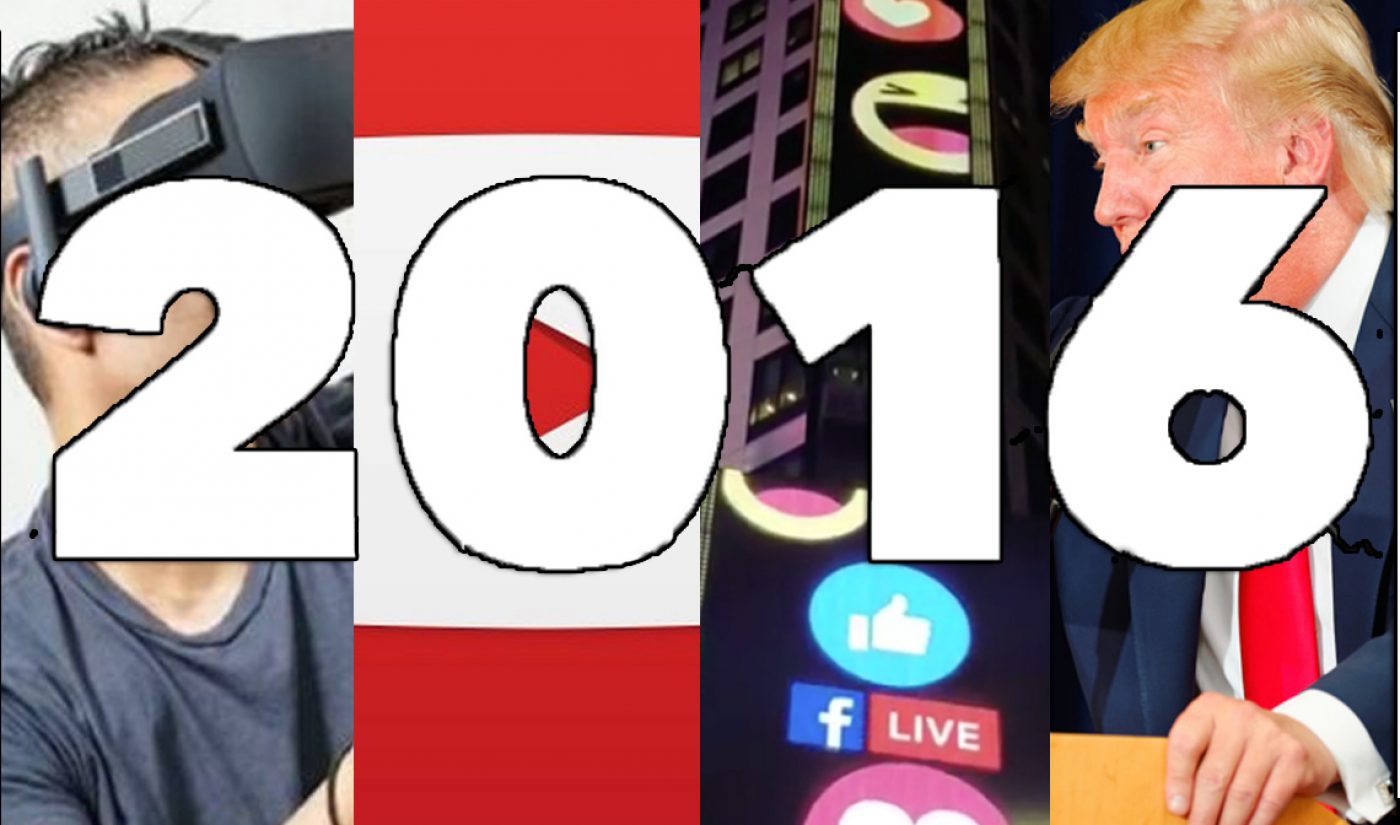The online video industry encompasses everything from the short, user-generated clips of Instagram to the hour-long epics of Netflix. Some of the creators who work within it operate out of their bedrooms, while others work with hundreds of peers at major media companies. Some of its major players are fresh on the scene and looking to challenge competitors that have been active for more than decade.
Many of these formats, creators, and platforms took strides forward in 2016, often moving in different directions from one another. How. then, can the online video year that was be summed up in five points? It’s no small task, but here’s my attempt:
Live streaming becomes a battleground, and everyone wants their piece of the pie

Subscribe to get the latest creator news
If you’re even a semi-regular reader of this publication, you’ll know how much space we’ve devoted to live videos and the many different companies looking to produce and distribute it. As video technology has advanced, most online video consumers in the United States can now access the bandwidth they need to watch live video for minutes, hours, or even days at a time.
In turn, online video producers have realized the high level of engagement, viewer retention, and watch time live streaming offers, and they have devoted massive resources to the proliferation of content within that format. In one month alone, Facebook spent more than $16 million advertising its live video capabilities, and it has shelled out millions more to bring attractive streaming content to its shores.
While Mark Zuckerberg’s tech giant is leading the way when it comes to live spending, other platforms are going on their own acquisition sprees. Twitter has picked up the rights to NFL games and red carpet shows, YouTube made sure it was the destination of choice for consumers who wanted to watch digital coverage during the presidential debates, and Amazon linked itself more closely to its subsidiary Twitch, which it acquired back in 2014 for close to a billion dollars.
It’s not just Silicon Valley titans duking it out for control of live viewers. Two companies that experienced explosive growth in 2016 were Musical.ly and YouNow, both of which appealed to younger consumers with hip, mobile-first approaches and addictive, gamified interfaces that encouraged viewers to stick around for long stretches of time. Now, at the end of the year, those apps have fostered their own creative communities, and brand money is flowing freely into them.
That last part is key, because the real winner of the live streaming boom is creators. Some of them are making tens of thousands of dollars per week through broadcasts alone, and media companies, especially BuzzFeed, profited off a bull market by cutting deals with multiple platforms.
The best part, as far as creators are concerned? The streaming boom seems as if it will continue unabated into 2017. Technology is still improving (with BamTech serving as a major innovator), and young viewers, who are innately comfortable with live streaming, are only going to grow in number. Live is going to stay lively.
Everyone loves VR, but it’s still a young medium
At the 2016 NewFronts, no buzzword was buzzier than “VR.” Everyone from AOL to Refinery29 hyped their plans within the world of virtual reality, and many distributors showed off their own 360-degree video projects.
VR has always been inherently cool, if a bit gimmicky, but media companies are particularly excited about it now because the devices on which it can be distributed are becoming more common. As our columnist David Bloom wrote back in October, VR is entering the mainstream, with companies like Sony and Google grabbing their own market shares.
That said, VR is still young. It is telling that the majority of 360-degree projects we spotlighted this year came from brands, digital publications, and, to put it bluntly, money people. For individuals, purchasing a VR camera rig is quite the investment, and without user-generated content complementing the offerings of media companies (in the same way musical.ly, YouNow, and Twitch complement the live streaming offerings of YouTube, Facebook, and Twitter, for example), VR as an industry can only grow so much.
As with live streaming, VR will be helped by technological improvements that will make it more common, but at this stage, it is still hard to predict the changes the medium will undergo as it evolves. Around the 2008 launch of YouTube Live, for example, would anyone have predicted that the future of live streaming would be include a large portion of mobile viewership?
VR will grow in 2017. People will use 360-degree setups to do more cool stuff. But for now, it would be wise to take the NewFronts VR hype with a grain of salt.
Streaming video goes niche, and the field becomes more crowded
In 2016, people complained about the diminishing size of Netflix library, which has shrunk over the past four years. The leader in streaming video on-demand (SVOD) programming has realized that its most efficient offerings are original shows like Stranger Things rather than the content it licenses from other sources. That strategy makes financial sense for Netflix, but it has left some consumers frustrated with their perceived lack of options.
Enter the niche SVOD service. 2016 saw the launch of Fullscreen, VRV, Seeso, Alpha, FilmStruck, and several other platforms that have appealed to specific audiences rather than the streaming population at large. These newcomers are operating under the assumption that comedy nerds (in the case of Seeso) or film buffs (FilmStruck) or social-savvy teens (Fullscreen) will pay a few extra bucks per month in order to receive an entertainment experience perfectly catered to their interests.
In a way, that’s a similar philosophy to the one that drives the crowdfunding service Patreon, which is now beloved among many independent content creators. Patreon treats individual channels as their own SVOD services as asks fans to pay-what-they-want for their “subscriptions.” The new niche SVODs feature non-optional price tags, but a greater breadth of content as well. It’s as if they are filling in a gap between independently-produced web content and the big money offerings of Netflix and Amazon.
Most of the aforementioned niche SVODs are too new for us to know if they are succeeding in their quests to attract passionate users. On one hand, Netflix’s continued preference toward its own originals is good news for the VRVs and Alphas of the world. At the same time, content is still king. Will smaller players that can’t throw around Netflix-sized sums of money be able to build the enticing libraries they need to attract subscribers? We’ve seen some interesting bets so far.
YouTube’s community stays online, but it is still thinking big
If 2014 and 2015 were the years when YouTube stars came to TV, 2016 was the year they stayed online. Platforms like YouTube Red, Go90, and Vimeo emerged as powerful partners for creators who want to step beyond their small-time origins and move into more premium territory with their own serial projects, feature films, or specials.
This has been a paradigm shift that makes sense. It is more natural for someone who built an audience through digital means to bring his or her fans to another digital platform rather than a TV channel. Many YouTube viewers have come online because they don’t like the rigid schedule and limited offerings of TV, and they don’t want to pick up a cable subscription in order to watch the shows produced by their favorite digital-native creators.
With the rise of digital-first projects led by YouTube stars and distributed on digital- and mobile-first platforms, it is reasonable to wonder if YouTubers, from this point on, will be able to launch big-budget projects while sidestepping TV and movie theaters entirely. The answer to that question is dependent on the financial success of platforms like YouTube Red and Go90. As long as they remain active and eager to spend, social media stars will have plenty of opportunity to share their passion projects without have to worry about the drawbacks that come with a move to the traditional media world.
On political issues, YouTube and its stars go left
For Americans, the defining event of 2016 was the presidential race, and social media influencers showed they were not afraid to voice their opinions. A movement led by Casey Neistat implored creators to be open about their political views, and for the most part, YouTube’s top stars — as well as the site itself — leaned left. It was perhaps an appropriate twist that Hillary Clinton’s final get-out-and-vote message was delivered not through a TV spot or a banner ad, but rather through Tyler Oakley.
YouTube’s status as generally left-leaning should not be a surprise. Its audience is generally young, and young people tend to be more liberal than their elders. In recent years, YouTube stars have been encouraged to be more open and forthcoming about their personal lives, a movement that has meshed with the left’s focus on identity politics.
It will be interesting to watch, then, as YouTube’s political identity clashes with Washington’s. The Obama administration’s media output included several collaborations with digital stars; logically speaking, the Trump administration will feature fewer of those opportunities (though the president-elect himself does seem to enjoy YouTube).
What will an anti-establishment YouTube look like? Will the same digital audience that paid real dividends for Obama be able to form any sort of tangible protest movement against Trump? Will the right-wing side of the online video industry become more vocal? We’ve started to see a few answers, but starting on January 20th, we’re going to get more.








